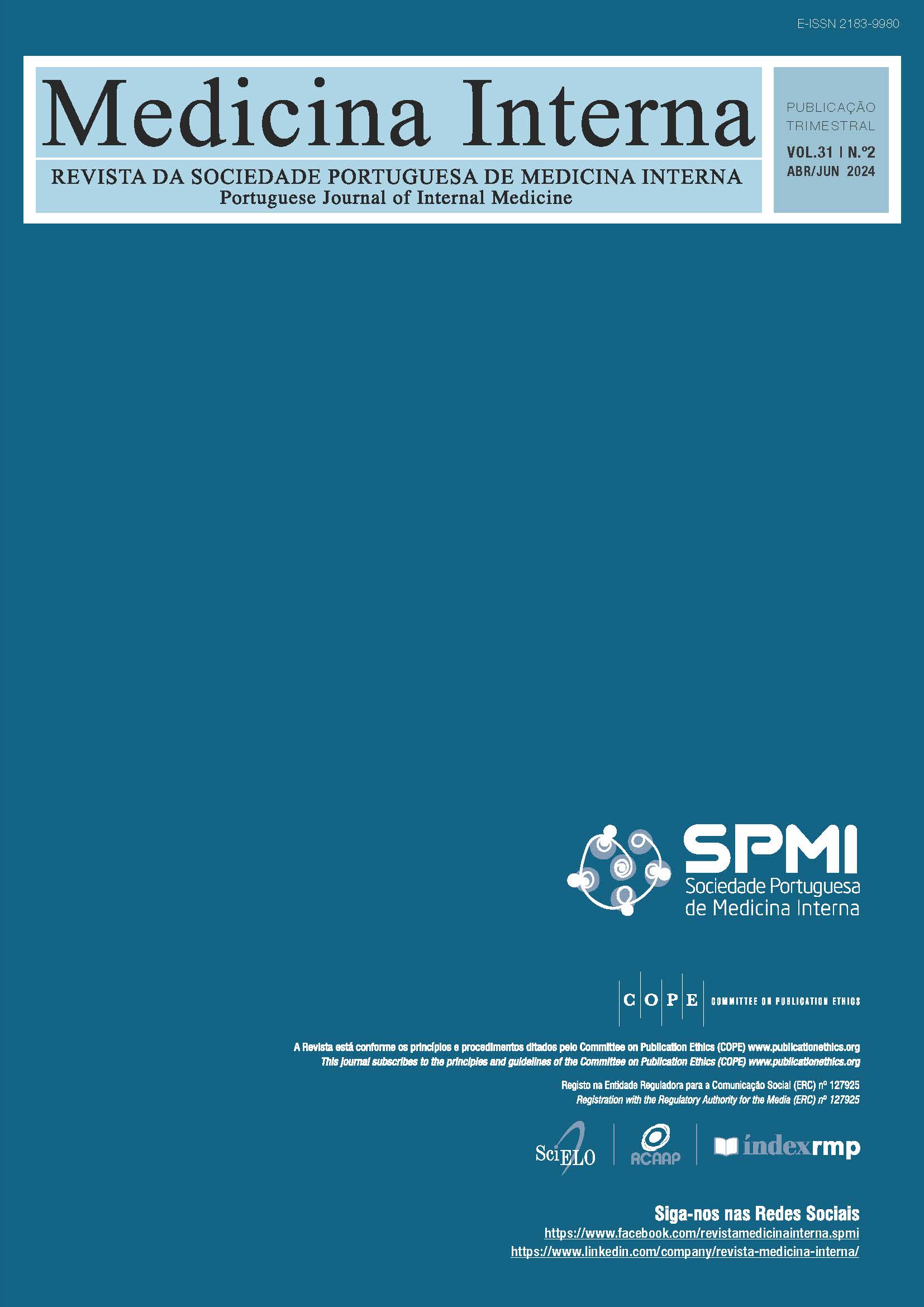Screening for Diabetes and Pre-Diabetes among Patients Admitted to an Internal Medicine Ward
DOI:
https://doi.org/10.24950/rspmi.2363Keywords:
Diabetes Mellitus/diagnosis, Glycated Hemoglobin, Prediabetic StateAbstract
Introduction: The estimated prevalence of diabetes in
Portugal is 14.1%, with only 56% of cases being diagnosed.
When including pre-diabetes, the joint prevalence reaches
42.7%. This study aimed to determine the prevalence of undiagnosed cases of diabetes and pre-diabetes among patients admitted to an Internal Medicine ward, thereby assessing the relevance of routinely conducting glycated hemoglobin (HbA1c) determinations for all admitted patients.
Material and Methods: In this descriptive observational
cross-sectional study, patients admitted to an Internal Medicine ward over a 15-week period were analyzed. Patients were excluded if they met any of the following criteria: a prior diagnosis of diabetes, the presence of pathologies or conditions that could interfere with HbA1c measurements, or if screening would not be beneficial due to clinical or ethical considerations. After identifying eligible patients, HbA1c levels were determined, and patients were categorized as “Without Diabetes”, “Pre-Diabetes” or “Diabetes”, with corresponding prevalence rates calculated.
Results: Out of 518 hospitalized patients, 207 (39.96%) met the eligibility criteria. Among them, 88 (42.51%) patients had pre-diabetes, while newly diagnosed diabetes cases
accounted for 10.15% (n = 21) of the eligible population.
Conclusion: Given the rate of initial diabetes diagnoses,
routine screening upon admission appears relevant and
ought to be considered according to local context.
Downloads
References
Sociedade Portuguesa de Diabetologia. Diabetes: Factos e Números – Os Anos de 2019, 2020 e 2021 − Relatório Anual do Observatório Nacional da Diabetes. SPD: Lisoba; 2023.
American Diabetes Association Professional Practice Committee. 2. Classification and Diagnosis of Diabetes: Standards of Medical Care in Diabetes-2022. Diabetes Care. 2022;45S17-S38. doi: 10.2337/dc22-S002.
Capozzi JD, Lepkowsky ER, Callari MM, Jordan ET, Koenig JA, Sirounian GH. The Prevalence of Diabetes Mellitus and Routine Hemoglobin A1c Screening in Elective Total Joint Arthroplasty Patients. J Arthroplasty. 2017;32:304-8. doi: 10.1016/j.arth.2016.06.025.
Mazurek JA, Hailpern SM, Goring T, Nordin C. Prevalence of hemoglobin A1c greater than 6.5% and 7.0% among hospitalized patients without known diagnosis of diabetes at an urban inner city hospital. J Clin Endocrinol Metab. 2010;95:1344-8. doi: 10.1210/jc.2009-1151.
Greci LS, Kailasam M, Malkani S, Katz DL, Hulinsky I, Ahmadi R, et al. Utility of HbA(1c) levels for diabetes case finding in hospitalized patients with hyperglycemia. Diabetes Care. 2003;26:1064-8. doi: 10.2337/diacare.26.4.1064.
Kufeldt J, Kovarova M, Adolph M, Staiger H, Bamberg M, Häring HU, et al. Prevalence and distribution of diabetes mellitus in a maximum care hospital: Urgent Need for HbA1c-Screening. Exp Clin Endocrinol Diabetes. 2017; 126: 123-9. doi: 10.1055/s-0043-112653
Nanayakkara N, Nguyen H, Churilov L, Kong A, Pang N, Hart GK, et al. Inpatient HbA1c testing: A prospective observational study. BMJ Open Diabetes Res Care. 2015; 3:e000113. doi: 10.1136/bmjdrc-2015-000113
Wexler DJ, Nathan DM, Grant RW, Regan S, Van Leuvan AL, Cagliero E. Prevalence of elevated hemoglobin A1c among patients admitted to the hospital without a diagnosis of diabetes. J Clin Endocrinol Metab. 2008;93: 4238-44. doi: 10.1210/jc.2008-1090
Müller-Wieland D, Merkel M, Hamann A, Siegel E, Ottillinger B, Woker R, et al. Survey to estimate the prevalence of type 2 diabetes mellitus in hospital patients in Germany by systematic HbA1c measurement upon admission. Int J Clin Pract. 2018; 72:e13273. doi: 10.1111/ijcp.13273
Downloads
Published
How to Cite
Issue
Section
Categories
License
Copyright (c) 2024 Internal Medicine

This work is licensed under a Creative Commons Attribution 4.0 International License.
Copyright (c) 2023 Medicina Interna






